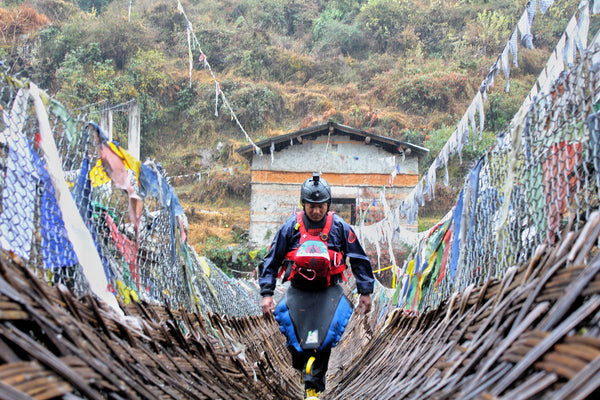Exploring Remote Parts of India | A Kayaking Trip to Arunachal Pradesh
Mar 07, 2019
Written By: Pramod Magar
I have explored different rivers in India and Nepal with my kayak, but these rivers in the Northeast of India were definitely some of the most adventurous and unexplored. Not very accurate maps of rivers, unexpected weather changes, changing water levels, and at last a broken kayak made our trip much more adventurous and asked for more improvisation talent than we expected but also made sure we had a good amount of challenges and a lot of fun.
We didn't really know what to expect when we started our trip to the Northeastern part of India, one of the most unexplored areas of this country close to the Chinese border. Arunachal Pradesh is one of the 29 states of India which is to a major part still claimed by China. What awaited us was definitely worth the 60-hour nonstop drive through Northern India: a paradise for any adventure enthusiast who likes to go off the beaten track. The places and rivers we saw are difficult to put in words. I'm trying my best to share some of my impressions of more than a month in one of the most beautiful parts of India: Arunachal Pradesh.
My trip was actually a combination of taking part in the Mechukha Adventure Festival on 23rd to 25th of November 2018 (competing there and supporting the judging team during the event), secondly working for Expeditions India as a safety kayaker and chef cook for a group of ten people from 1st till 12th of December and finally exploring with three kayaking friends remote rivers in Arunachal close to the Bhutan and China border.

Not an unusual sight in India: The road full of cars and trucks but nothing is moving. So we decided to drive on the opposite side to make it on time to Mechukha. Gorakhpur highway, Photo - Pramod Magar
Our adventure already started in Rishikesh as we had to drive nonstop for 60 hours from Rishikesh (Uttarakhand) to Mechukha (approx. 2700 km). Mechukha is a small village in the Northeastern Himalayan range where the Arunachal Pradesh government is organizing for the 6th time an adventure festival with up-to 100 participants from all over the world. There are competitions in different adventure sports such as paragliding, mountain biking, and kayaking. The location is unique and actually the perfect spot to promote adventure tourism in Arunachal, a part of India which is yet to be explored.

We were actually supposed to reach the festival the night before but as the VIP guest Salman Khan (Bollywood super super star) also couldn't reach on time, our competition happened to start a bit later than planned (not so uncommon in India) and we were there just on time. Even though I hadn't slept properly for a few days and had a long drive behind me, I was able to win the long marathon.
The festival has been planned well and we had an awesome time at the event. Mechukha is one of the most beautiful places we have been so far in India, and we would definitely recommend this event to outdoor sports lovers.

Kayakers from Rishikesh competing in Mechukha - Photos- Ashish Gupta
After the festival, my work trip started for Expeditions India, led by its owner Anvesh Thapa. We have done many trips together and each time with Anvesh is a learning experience for me. He is kind of a mentor for me. He is one of the most talented river guides and has a full of respect for nature.
We were rafting and kayaking the Kameng river during this trip with 10 clients.The Kameng River (previously named Bhareli River) comes from the Gori Chen mountain at an elevation of 6,300 m on the India-Tibet border. It's a beautiful river corridor surrounded by a few national parks. On this trip, I was working as a safety kayaker and chef cook. The trip was actually great fun and the money I was making on this trip helped me to stay longer in Northeast India and explore more rivers.

Local rafters from Arunachal, Nameri - Photo - Pramod Magar
We met another local expedition team on the river which was run in a different style: going on class four rapids without helmets, their guide didn't have PFD, no dry bags, all the clothes, tents and food were wrapped in a big plastic tarp. A few old-time rifles were also on board as they were doing a hunting/fishing trip.
After this expedition, our kayaking adventure started. When I say “our” I have to mention that in reality it was Chotak who was dreaming about exploring as many rivers in India as he can with his local boys from Rishikesh, and after thinking about this for the last two years he asked Stanzing, Rishi and I to join the trip. I would say it was kind of a “go with the flow thing”, because during the actual planning phase Chotak was in Bhutan, and I was away on a ten-day kayaking expedition. But in the end, it all worked out really well for us. We listened to local people’s advice on where to go and which part of the river to explore. Out of four of us, Chotak and Rishi had been in Arunachal before but not on these rivers. There had been a few kayakers before us on these rivers but many years ago.
Day 1 on Dirang river
We had started our first-day kayaking on Dirang river. Dirang is a pretty big town for being up in the mountains. The main road leads through this city connecting to the Bhutan and China border. When we reached our campsite, Chotak got a message from a local friend saying there is a bigger river close to Tawang. He didn't know the name of the river and the only thing he said was that it's too hard - you guys won't be able to paddle this river. Of course, this remark caught our kayaker hearts!
After trying Google Map for quite some time we decided to call the Indian river legend Shalabh Gahlaut. He was there around ten years ago with his friends kayaking Northeastern rivers of India. He told us this river with the name Tawangchu has only been run two times before us and would be one of the harder rivers for an expedition and all other logistics.
For us, it was clear that that's where we wanted to go next. So the very next morning we got all our things together and headed towards Tawang.

Crossing one of the high altitude passes in Northeast with a frozen lake. Sela pass at 13700 feet - Photo - Pramod Magar
For sure Tawangchu was the hardest river for all of us. We were unlucky with the weather as it was raining for two days. After spending one and a half days on the river, we had to get out of it. For anyone who is interested in going to Tawangchu in the future, they can use the bridge (see photo below) with prayer flags as a landmark - below this is a solid class 5 rapid. Unfortunately, the river was too high and we couldn't run the rapid. We stayed in a village called Chaksam which is just above the rapid and waited for the river to go down. We were lucky to meet really lovely people in the village, they offered us their house to stay and nice food. The hospitality of these people has been really touching. We asked people around if they had seen any kayakers going down the river before us. None of the young folks had seen anyone but some of the old people said they saw two kayakers going down the river a long time back and what stayed in their memory was that one of them was floating through the rapid.

Tawangchu River Pramod Magar, Chaksam - photo - Stanzin Tanfan
We finished kayaking on Tawangchu very close to the Bhutan border at the SSB Camp and the Nyamjungchu River was only four hours away from us so we drove to Lumla town. All of us were really hungry, we had lunch, did some shopping and started driving towards our next river.
We were the second group of kayakers who managed to paddle the river Nyamjungchu all the way down to the Bhutan border. We started at a small town called Gorsam, close to the Tibet border. This place has the biggest Buddhist stupa in Arunachal, built in the 12th century.
Nyamjungchu flows through a long deep canyon with some classic whitewater. Also while paddling the Nyamjungchu and Tawangchu river we had to be real careful since all these rivers were going to Bhutan and we didn't want to cross the border accidentally without visa/permission. We had heard of the first two kayakers who came to paddle these rivers. They crossed the border and went to Bhutan. And as they didn't have a visa they got restricted to never enter Bhutan again.

Pramod Magar, laudung - Photo - Pramod Magar Early morning setting up the fire
Dirang 2nd time
After finishing these two rivers it was time to go back to Dirang river and complete the whole river. When we came to the Dirang River for the second time, the water level was running pretty low. The landscape and canyon are really amazing. Unfortunately, Chotak damaged his boat. We fixed it twice on the river but the split was too big and our fixing didn't work for long. So we decided to end our kayaking trip at the confluence of Dirang and Bichom.
After spending nearly one and a half months in Arunachal and probably 30 days on the river, I have to say that the rivers of Arunachal had been some of the most challenging and beautiful rivers I have been to so far. Arunachal Pradesh is one of the best places to kayak and gives you that feeling of exploring remote and untouched areas. Pretty much every single valley has good rivers flowing through them. Few of them have been already explored and many yet to be explored. Our trip ended here but I will always be happy to go back and try out different rivers.
Being experienced kayakers helped us assess each river and not overestimate our own skills. It was also a good lesson to always keep respect for unknown rivers and don't overestimate yourself and that of the kayak.
I have to thank my kayaking friends Stanzing Tanfan and Rishi Rana and first of all Tsering Chotak for planning this trip, as well as our driver Stanzng Namgyal for making this trip possible and sharing some of the best kayak moments so far in my life. Also, my gratitude goes to Immersion Research, Dagger Kayaks and Good Wave Adventure who have been a huge support for this trip.
Want to know more about Pramod and his unique paddling story growing up in India? Check out this feature by the BBC.






